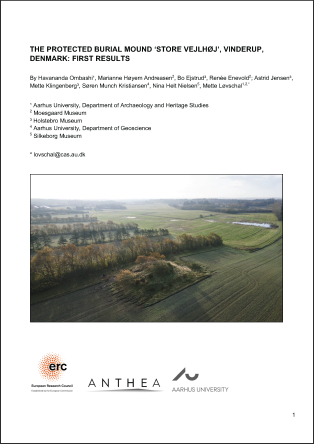The Protected Burial Mound ‘Store Vejlhøj’, Vinderup, Denmark: First Results
Nøgleord:
pollen, Bronze Age, Denmark, Barrow, heathlandSynopsis
An archaeological excavation of the protected burial mound Store Vejlhøj in northwestern Denmark was carried out in October-November 2021. The excavation formed part of the ERC-funded research project called ANTHEA, focusing on the deep history of anthropogenic heathlands. It was conducted by Aarhus University in collaboration with Holstebro Museum and Moesgaard Museum. The aim was to test a new method of sampling pollen data from different construction stages in a burial mound and comparing them with pollen data from nearby lake sediments with a view to improving our understanding of prehistoric anthropogenic heathland dynamics. Prior to the excavation, soil cores were collected from two nearby peat sediments as well as six burial mounds (including Store Vejlhøj) within a 1 km range of Lake Skånsø, where previous pollen analyses had been carried out.
Based on these preliminary corings, Store Vejlhøj was selected for further archaeological investigation. A dispensation for excavating the protected mound was granted by the Danish Palaces and Culture Agency. The excavation was based on a 5 m long trench through the barrow, moving from its foot inwards. The surface vegetation and 40 cm topsoil were removed by an excavator, after which the remainder of the trench was manually dug in horizontal layers. Observation conditions were good. The excavation revealed a series of well-defined barrow construction stages, as well as unusually wellpreserved turf structures. Only two archaeological finds could be related to the barrow, both of which were later than its initial construction: a secondary urn in the top layer, and the base of a second urn at the foot of the mound.
The burial mound was constructed using a minimum of three shells, which could be observed in the trench profile. Turfs were most probably collected locally in a landscape dominated by grass pastures, where no previous turf cutting had taken place. A total of 34 soil samples were collected for paleoecological analyses (pollen, Non-Pollen Polymorphs (NPPs), macrofossils) and geoarchaeological analyses (micromorphology, bulk samples). Preliminary pollen and macrofossil results from the burial mound revealed poor preservation conditions, which prompted a trench extension of 0.5 m by 0.2 m to find better preservation conditions. This extension resulted in the collection of a single final macrofossil sample, although there was no identifiable change in the in-situ preservation conditions.
The dating results of the mound have not yet been completed and will be included as appendix 4-6 in 2023.

